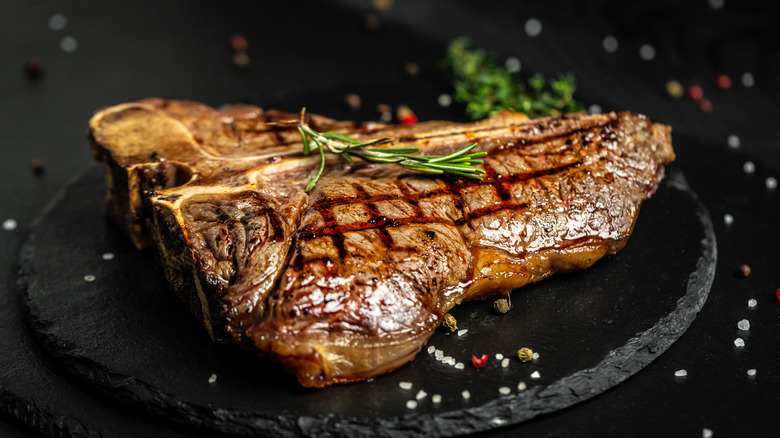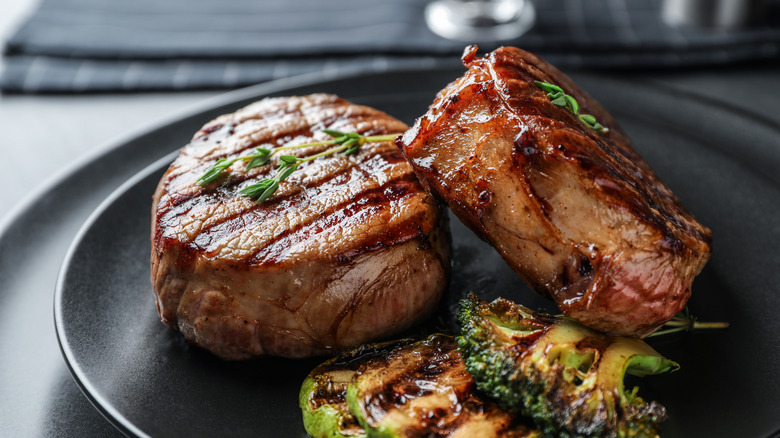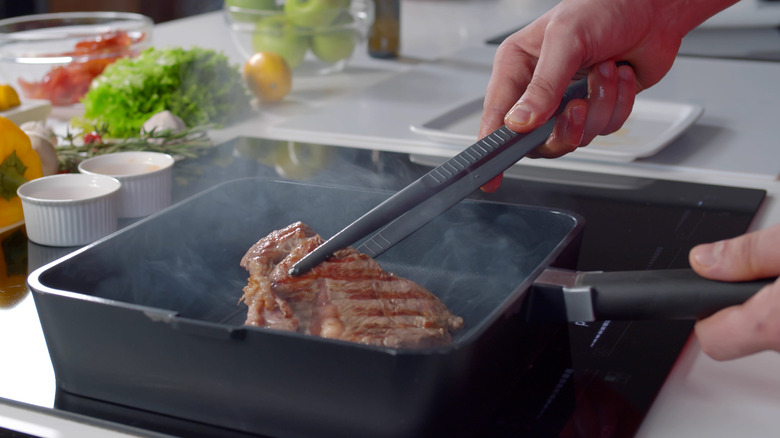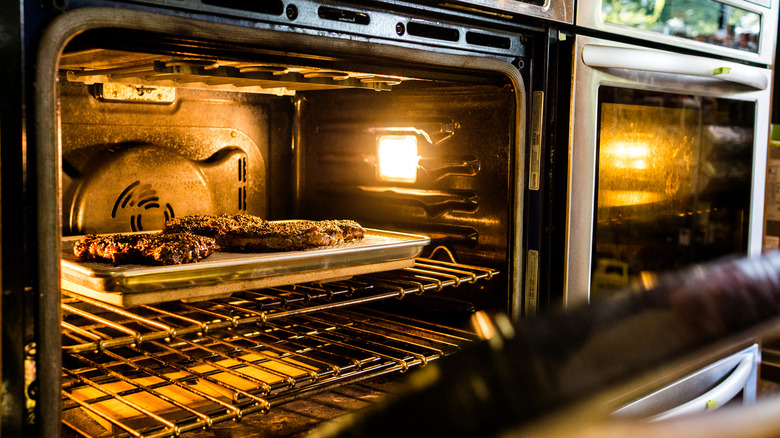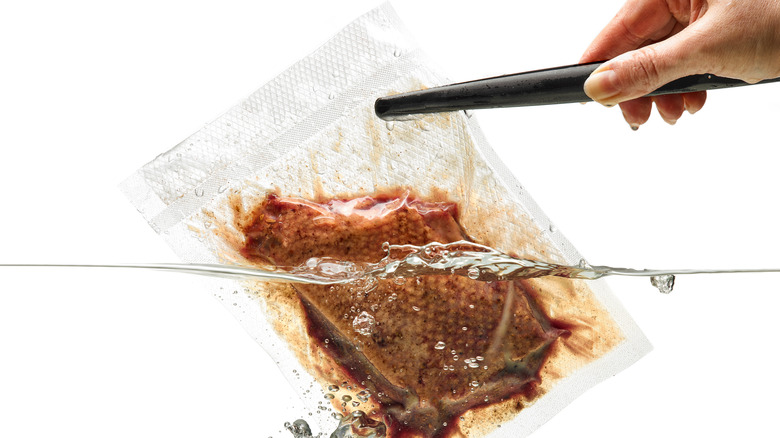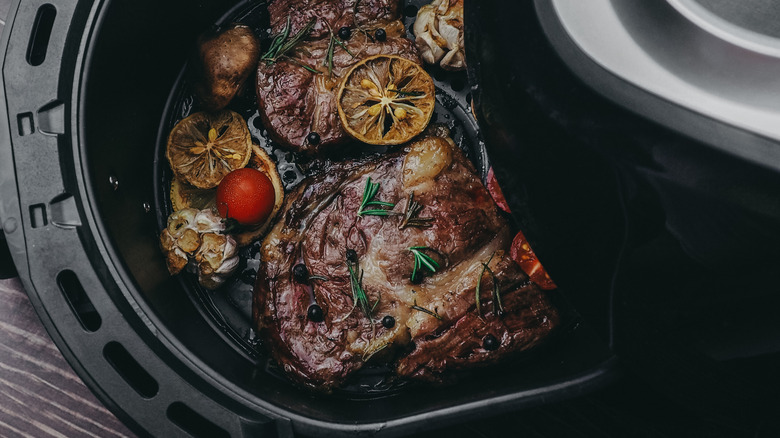Here's How You Should Be Reheating Steak
While most of us would much rather be eating all of our steaks at a prime steakhouse, usually it's a luxury best reserved for special occasions. That's not to say, however, that store-bought steak grilled up at home isn't any good. Sirloin from the supermarket can be just as tender and delicious as the kind prepared in a restaurant. Reheating it the next day is where things get tricky.
No matter how perfectly grilled it was initially, when you warm-up leftover steak, you run the risk of overcooking it. An extra hot oven, or a few seconds too long in the microwave can easily turn your once tender, juicy steak into a dry slab of meat that only tastes edible when doused in A1. It's not that it's impossible to reheat steak, but rather that steak, even after cooked, is particularly sensitive to temperature. Thankfully, with a few cooking techniques up your sleeve, your steak will actually be able to maintain its integrity even through the reheating process.
Microwave
When you go to warm up your leftover steak, chances are the microwave is your go-to, solely for the sake of convenience. For most foods, you can just stick it on a plate and press start, but microwaving a steak requires a bit more attentiveness, Allrecipes states. To properly microwave steak, you must do so by first covering it with a damp paper towel. Microwaves tend to zap moisture from food, but the residual water in the paper towel can prevent this from happening, as it adds and traps moisture as the steak reheats.
To prevent the overcooking that typically occurs in the microwave, All Recipes also suggests lowering the microwave power setting to medium, and microwaving the steak in increments of no more than 30 seconds, flipping the steak in the process. Until the steak gradually reheats, this can be repeated as necessary, but All Recipes says you probably won't need any longer than two minutes.
Stove
Reheating steak on the stove is possible, but you'll have to decide whether you prefer it juicy on the inside, or if you want to retain its seared exterior. If you want to retain the sear, you'll need an extra teaspoon of oil, as per the method shared on Allrecipes. You'll add this oil, along with the steak, into a pan over medium low. Then you'll cover it with a lid to let the heat circulate, and within a few seconds it'll be good to go.
If you can do without the sear and prefer your steak to remain as tender as possible, Taste of Home suggests adding beef broth. Pour a shallow pool of beef broth in a nonstick skillet, and bring it to a simmer over medium heat. Once bubbling, add the steak, and cook for a total of two minutes. The result is a perfectly reheated steak that's every bit as tender as it was when it was fresh off the grill.
Oven and stove
Microwaves tend to be finicky because you can't control the exact temperature inside, and that's precisely why Cook's Illustrated recommends both the oven and stove for reheating steak. With this method, you'll monitor both the temperature of the oven and the inside of the meat.
Start by preheating your oven to 250 degrees Fahrenheit, then place the steak on a wire rack situated atop sheet pan. Bake the steaks until the internal temperature of the meat reaches 110 degrees Fahrenheit. This will take about 30 minutes, depending on the thickness of the steaks. At this point, you'll pat dry the steaks with a paper towel, and sear them in an oiled skillet over high heat. After 60 to 90 seconds per side, the steaks should read 125 degrees Fahrenheit to 130 degrees Fahrenheit internally. That's when you know they're ready to serve up for a second time. Just don't forget to let them rest for five minutes before cutting.
Sous vide
If you're really serious about reheating your steaks, you may want to bust out the sous vide (via The Kitchn). Of course, not everyone has an actual sous vide on hand, so a Ziploc bag and a pot of water will suffice too.
For this method you'll first remove your steaks from the fridge and let them return to room temperature. While the steaks are thawing, heat a pot of water on the stove to 130 degrees Fahrenheit. Note that if you don't have a thermometer on hand, 130 degrees Fahrenheit is well below the simmering point of water, so it should be warm but not hot, and definitely not boiling. When the steaks have reached room temperature and the water is 130 degrees Fahrenheit, it's time to sous vide. Transfer the steaks into airtight tight Ziploc bags, then submerge them in the warm water. Let the steaks sit in the sous vide for about five minutes, after which they should be fully reheated.
Air fryer
We don't always have all the time in the world to sous vide a steak, or patiently move it to and from the oven to the stove. If you're eager to get your leftover steak on the table and would rather use a method that's a little less involved, look no further than the air fryer.
According to Love Food Not Cooking, an air fryer is efficient because it reheats both sides of the meat at the same time, making it less prone to overcooking. Once the air fryer is properly preheated to 380 degrees Fahrenheit, spray or brush the steak with a bit of olive oil, and set it in the fryer basket. Make sure not to overcrowd the basket so every surface is exposed, then all that's left to do is let the air fryer to its magic. Flip your steak every two to three minutes until the internal temperature reads 110 degrees Fahrenheit, and it'll be ready to eat before you know it.
